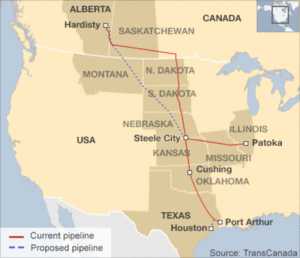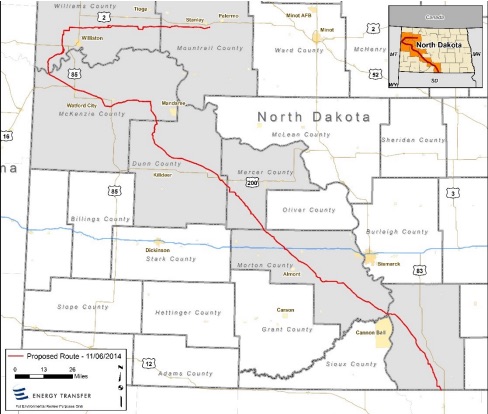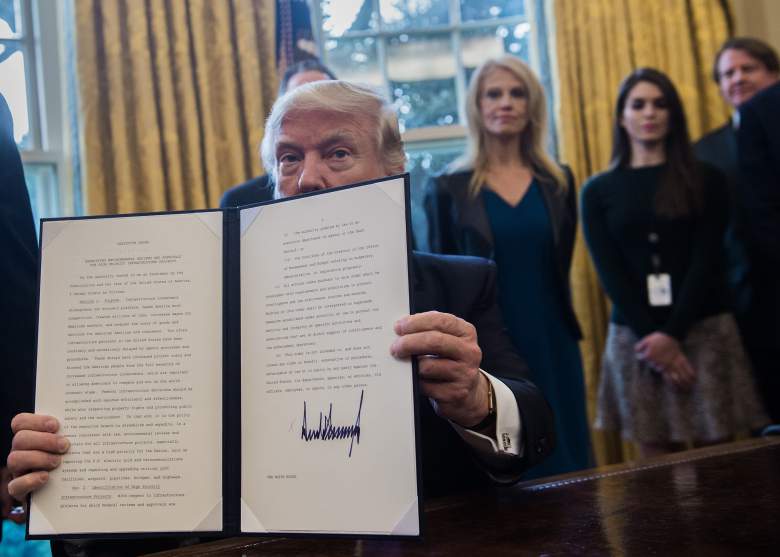UNITED STATES—President Donald Trump signed several high-level directives to recommence construction of the Dakota Access and Keystone XL pipelines on Tuesday, January 24 – just four days into the new Administration.
These orders, called “memoranda”, make good on President Trump’s 2016 campaign promise to stimulate domestic fossil fuel production and give “a big piece of the profits” to the American people. The orders—which aim to expedite the pipelines’ construction—and the priority they were given signal to Trump supporters in the fuel industry that the major policy changes he proposed on the campaign trail were not empty promises.
The directives come in light of the Obama Administration’s restriction on oil and gas development – which was fiercely opposed by republicans on the grounds it seized economic opportunity, yet widely supported by democrats and environmentalists who backed President Obama’s campaign initiative to transform the United States into “a global leader when it comes to fighting climate change.” Because of this, President Trump’s orders to move forward with the pipelines’ construction have been met by both tremendous opposition and praise, as well as raised the question: What will these orders actually do?
To understand the specifics of the memoranda, it’s important to understand the specifics of the pipelines:
Keystone XL Pipeline
The Keystone XL Pipeline was approved by the Canadian National Energy Board in March 2010 and stirred years of debate. In late 2015, President Obama formally refused to issue the US presidential permit required for the pipeline’s construction upon advisement from the Environmental Protection Agency (EPA) to do so, and on the grounds that the project would not significantly lower petroleum prices, create long-term jobs, nor affect energy dependence. Following Obama’s decision to deny approval, TransCanada, the company behind the project, sued the US for $15 billion under the North American Free Trade Agreement (NAFTA), seeking reimbursement for the costs it incurred awaiting a final decision, according to a pending Request for Arbitration filed on June 24, 2016.

If completed under Trump, the 1,204-mile—875 miles of which are located in the US— Keystone XL Pipeline will transport approximately 830,000 barrels of crude oil a day from the sands of Alberta, Canada, to Steele City, Nebraska, where it will connect to an existing pipe. The project’s completion would undo a major decision by Obama, who argued the Keystone XL would be seriously contributory to climate change, largely because it would transport tar sand crude oil – which is very thick and particularly greenhouse gas intensive because of the energy it takes to extract it.
“We’ll see if we can get that pipeline built,” Trump told the press the day he signed the orders. “A lot of jobs.”
Realistically, the Keystone XL Pipeline would not have a momentous affect on jobs nor the environment, according to studies. The State Department estimated that the Keystone’s construction would create only 35 permanent jobs and 42,000 temporary jobs for about two years – 3,900 of them in construction and the rest through indirect support, like food service, according to the State Department’s 2012 Keystone XL Pipeline Record of Decision and National Interest Determination. By that same token, the report concluded that the Keystone’s carbon emissions would equate to less than one percent of the total greenhouse gas emissions in the US.
“Keystone has never been a significant issue from an environmental point of view in substance, only in symbol,” David L. Goldwyn, an energy market analyst and former head of the State Department’s energy bureau, told the NY Times.
Dakota Access Pipeline
The DAPL—a $3.7 billion investment—is slated to stretch 1,172 miles underground across North Dakota, South Dakota, Iowa and Illinois, connecting the oil-rich Bakken and Three Forks production areas in North Dakota to existing pipelines in Patoka, Illinois.

The US is the world’s third-largest crude oil producer, but its number one consumer, meaning, it still relies on foreign imports for half of the oil it consumes daily, which equates to approximately $388 billion in importations annually. The DAPL would transport between 470,000 to 570,000 barrels of crude oil per day, powering the US on domestically produced oil, while largely eliminating its dependence on foreign fuel.
The U.S. Army Corps of Engineers (Corps), which has jurisdiction over domestic pipelines that cross major waterways, thus, the final federal approval needed for the DAPL’s construction, approved the project to move forward in July 2016, despite three federal agencies’ requests not to do so.
In the months leading up to its final decision, the Environmental Protection Agency (EPA), Advisory Council on Historic Preservation (ACHP) and Department of the Interior each individually called on the Corps to conduct a more comprehensive analysis of the pipeline’s potential impact before moving forward with its construction. The Corps’ decision sparked fierce protests and opposition, which were met by allegations of police militarization.
In December 2016, just six months after the DAPL was granted its final approval, President Obama ordered the Corps to perform another Environmental Impact Statement (EIS) on the project, ostensibly designed to explore alternative routes that would placate the mass protests being carried out by members of the Standing Rock Sioux Tribe – who reside just a half a mile from the pipeline’s proposed route and fear its construction will desecrate sacred burial grounds, as well as taint their sole means of drinking water, irrigation and fish: the Missouri River.
How will President Trump’s executive orders change this?
Neither executive order is a “green light” to recommence construction – both come equipped with caveats and several procedural hurdles that require the compliance of high-level decision makers within several federal agencies.
Keystone XL Pipeline
President Trump’s directive pertaining to the Keystone XL Pipeline ultimately invites the operator—TransCanada—to reapply for its cross-border permit, directs the U.S. State Department to “take all actions necessary and appropriate to facilitate its expeditious review,” and gives the State Department 60 days from receipt of TransCanada’s new application to issue a final decision.
“We are currently preparing the application and intend to do so,” TransCanada confirmed to reporters later that day. The company vowed it would create jobs, as well as “[protect] waterways and other sensitive resources.”
Even so, the State Department has several obstacles to clear before the project moves forward, including establishing a strong legal basis for reversing its previous order, which was made under the Obama Administration – since environmentalist groups will likely file suit over any decision enabling the pipeline’s completion.
In other words: It’s not a green light, but a positive development for TransCanada.
Dakota Access Pipeline
The Dakota Access Pipeline is at a different point in the approval process than the Keystone XL, thus, the directive related to it had to be drawn under different terms. The order was directed not to the company behind the project, Energy Transfer Partners, but the Army Corps of Engineers. The memorandum ordered the Corps to “take all actions necessary and appropriate” to conduct the review and approve the pipeline “in an expedited manner to the extent permitted by law and as warranted.” In other words, Trump’s order supersedes that of Obama, meaning, the Corps is no longer obliged to complete an EIS and even encouraged to scrap the process all together.
This raises the question: What orders by the Corps classify as “permitted by law and warranted”? It will likely opt for one of three options:
- The conduct of the new EIS and the long administrative process it entails continue uninterrupted
- The Corps decides that the review is in fact unnecessary, halts the process and orders the project proceed under the existing permits
- Secretary of Defense James Mattis issues a Secretarial Decision that will halt the EIS review process and allow the project to move forward
Regardless, the Defense Department and Corps need to ensure that whatever decision is made is supported by a strong legal framework in anticipation of the litigation to come.
President Trump has between $500,000 and $1 million invested in Energy Transfer Partners, as well as $1 million holding in Phillips 66, an energy company which will have 25 percent stake in the Dakota Access project once it’s completed, according to his 2016 Financial Disclosure Report. Last month, a spokesman for Trump told the NY Times he sold all of his stock in June, though there is no documentation to corroborate that.
What will happen next?
Environmental activists and thousands of protestors, which include Native Americans from more than 100 tribes, have demonstrated stark resistance to the construction of both pipelines. The Standing Rock Sioux Tribe and its supporters—who spent months protesting the construction of the DAPL in Cannon Ball, North Dakota, where they endured subzero temperatures—were particularly disheartened by President Trump’s order to “expedite” the project.
“I am, to a large extent, an environmentalist, I believe in it,” President Trump said during a meeting with auto industry executives. “But it’s out of control, and we’re going to make it a very short process. And we’re going to either give you your permits, or we’re not going to give you your permits. But you’re going to know very quickly. And generally speaking, we’re going to be giving you your permits.”
The pipelines’ critics have vowed to keep resisting. “The world’s climate scientists and its Nobel laureates explained over and over why [the pipelines’ construction] was unwise and immoral,” Bill McKibben, co-founder of the climate activist group 350.org, said in a statement. “In one of his first actions as president, Donald Trump ignores all that in his eagerness to serve the oil industry. It’s a dark day for reason, but we will continue the fight.”
“This is not a done deal,” McKibben said. “The last time around, TransCanada was so confident they literally mowed the strip where they planned to build the pipeline, before people power stopped them. People will mobilize again.”






